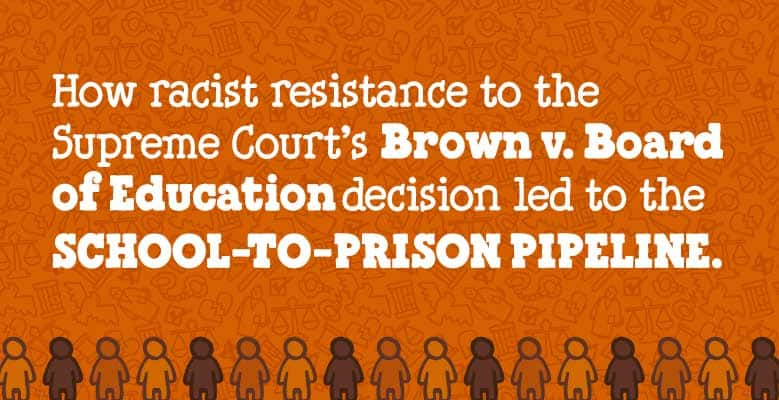May 17, 2021

With its landmark 1954 Brown v. Board of Education decision, the US Supreme Court put an end to the racist doctrine of “separate but equal” and declared school segregation unconstitutional. That monumental ruling was supposed to make things equal for Black students.
It didn’t.
Today, almost 70 years later, Black students still experience racism and bias at every level of the American educational system. Countless schools have embraced a new very separate and unequal system of discipline and punishment that seems to apply only to students of color. It’s called the school-to-prison pipeline, and it’s the result of racist resistance to the Brown v. Board of Education decision. Here’s what happened.
The Same Old Story
In the 1950s, a typical Black student attending a majority Black school had a vastly different daily classroom experience than a typical white student attending a majority white school. Black students went to school in buildings that were in bad condition, in districts that were dramatically underfunded. They used textbooks that were often out of date and had teachers who were poorly trained, unsupported, or even just plain unqualified.
Crumbling, unsafe schools, faltering academics, hardly any funding? Fast-forward to 2021… and not much has changed. The reasons why aren’t difficult to guess. We see every day how white supremacy and systemic racism have created two Americas—one experienced by white people, and the other by people of color. The pandemic made this duality clear. So did the insurrection at the Capitol on January 6. We see it in the disproportionate impact climate change is having on communities of color. We see it in our racist criminal legal system. Our educational system is no different. Black students and white students exist in very different worlds.
- Only about half of America’s 50 million public school students go to an integrated school.
- Mostly white school districts get $23 billion more in funding than majority Black districts, despite serving the same number of students.
Let’s be clear: School segregation and educational inequality is not simply a problem in what used to be the Jim Crow South. States like California, New Jersey, and New York are among the worst offenders.
Criminalizing Black Students
This kind of coast-to-coast inequality is what Brown v. Board of Education was supposed to address. Unfortunately, things got off to a rocky start. White districts in every part of the country fought for decades after the 1954 ruling to keep Black students out of their schools. Even so, after additional court battles and increased federal oversight, the percentage of Black students attending integrated schools reached as high as 90% by the 1970s.
That sounds like something of a success story, right? But here’s where things take another turn. Where efforts to maintain segregation ultimately failed, school administrators started turning to racist and exclusionary disciplinary policies that disproportionately targeted students of color.
This is what’s known as the school-to-prison pipeline:
- Black students are punished way more often, and more harshly, than white students, even when they engage in the same behavior.
- Majority Black schools are more likely to have police and security officers than majority white schools.
- Black and Brown students are more than twice as likely than white students, even when engaging in the same behavior, to be referred to or arrested by law enforcement at school.
- Contact with law enforcement at an early age makes it more likely that students will be trapped in the criminal legal system for the rest of their lives.
Research has shown that Black students do not misbehave more than white students. This has nothing to do with “good” or “bad” kids. But what’s absolutely clear is that this separate, unequal, and racist system leads to negative outcomes (and diminished opportunities) for students of color—lower academic performance, higher dropout rates, and more.
Support Students of Color
On this anniversary of Brown v. Board of Education, let’s be clear: Black and Brown students are still having a painfully separate and very unequal experience in America’s schools.
When majority Black school districts receive billions less in funding than majority white school districts, then nothing is equal. When Black students are punished, suspended, expelled, and arrested far more than their white peers for the same behavior, then nothing is equal. Brown v. Board of Education struck down a racist doctrine, but we have a lot more work to do before racism itself is banished from our educational system.
We hope you’ll join us in demanding that majority Black school districts get the funding they need and deserve. Let’s make sure that students of color are supported and protected by their schools—instead of funneled out of classrooms and into the criminal legal system.
Sweeten Up Your Inbox!
Subscribe Now And We'll Make Sure You Get The Inside Scoop On Ben & Jerry's Fun And Flavors! It's Like Dessert For Your Inbox, And You're Going To Want Seconds.

